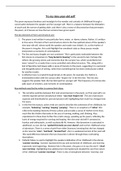‘To my nine-year-old self’
The poem expresses fondness and nostalgia for the wonder and curiosity of childhood through a
conversation between the speaker and her younger self. There is a balance between the idolization
of youth and the sorrow of getting older, and there’s also a sense of disconnection that permeates
the poem, at it focuses on how the two versions have grown apart.
The key elements of form and structure are:
1. The poem is not written in any particular form, meter, or rhyme scheme. Rather, it’s written
in free verse. This lack of form and structure mirrors the free-spirited nature of the speaker's
nine-year-old self, whose world the speaker and reader now inhabit. Or, as the rhythm of
the poem is irregular, this could highlight her emotional state as these pauses maybe
interpreted as moments of contemplation
2. The line and stanza lengths are not consistent- This is particularly noticeable between the
first stanza in comparison to “long buried in housing” in the second to last. Perhaps this
reflects the growing stories and memories that the narrator has, which would likely feel
more ‘natural’ to a reader than a very controlled and refined structure. This, along with a
lack of figurative techniques adds a sense of honesty to the poem, suggesting it is a personal
and thoughtful piece of writing, rather than something that has been meticulously crafted
for another reader.
3. A reflective tone is created through breaks in the poem, for example, the rhythm is
immediately broken with the caesura after ‘forgive me’ in the first line. This line also
suggests the speaker feels she has betrayed her younger self. The frequency of commas also
adds layers of emotion, and moments of contemplation.
Key methods used by the writer to convey their ideas:
1. The narrative switches between first and second person in the poem, as if her past self is an
entirely separate person and physical entity- ‘you must forgive me’. The use of pronouns
separate and disembody her past and present self, highlighting how much has changed over
the years.
2. In the first few stanzas, active verbs are used to describe the activeness of her childhood, for
example, ‘balancing’ ‘running’ ‘leaping’ ‘jumping’. There is an anaphora of ‘rather’-this
reflects the building intensity of these actions and provides a sense of rhythm to the lines,
much like the rhythm that exists in the acts of running, walking, and climbing. Also,
enjambment in these lines further the erratic energy, speeding up the poem, reflecting the
burst of energy required for running and leaping. Her nine-year-old self if conveyed as
fearless and enthusiastic, as well as physically fit. However, this dynamism is contrasted in
adulthood, as now she has ‘spoiled this body we once shared’ and lost her childhood sense
of adventure. There is a sense of grief from older Dunmore, knowing that she has changed
as she now has ‘scars’, ‘bad back’, ‘bruised foot’- she is a weakened version of her past self.
This stark difference between the two characters is driven through these contrasting
descriptions.
3. Pathetic fallacy is used to highlight the speakers idolisation of her childhood in the phrase
‘summer morning.’ Summer represents the joy and excitement of childhood, and morning
represents new beginnings. However late in the poem, she goes on to say she won’t ‘cloud
your morning’, highlighting how adolescence interrupted and clouded the care-free nature
of her childhood ‘summer mornings’. There is also a homophone between ‘morning’ and




